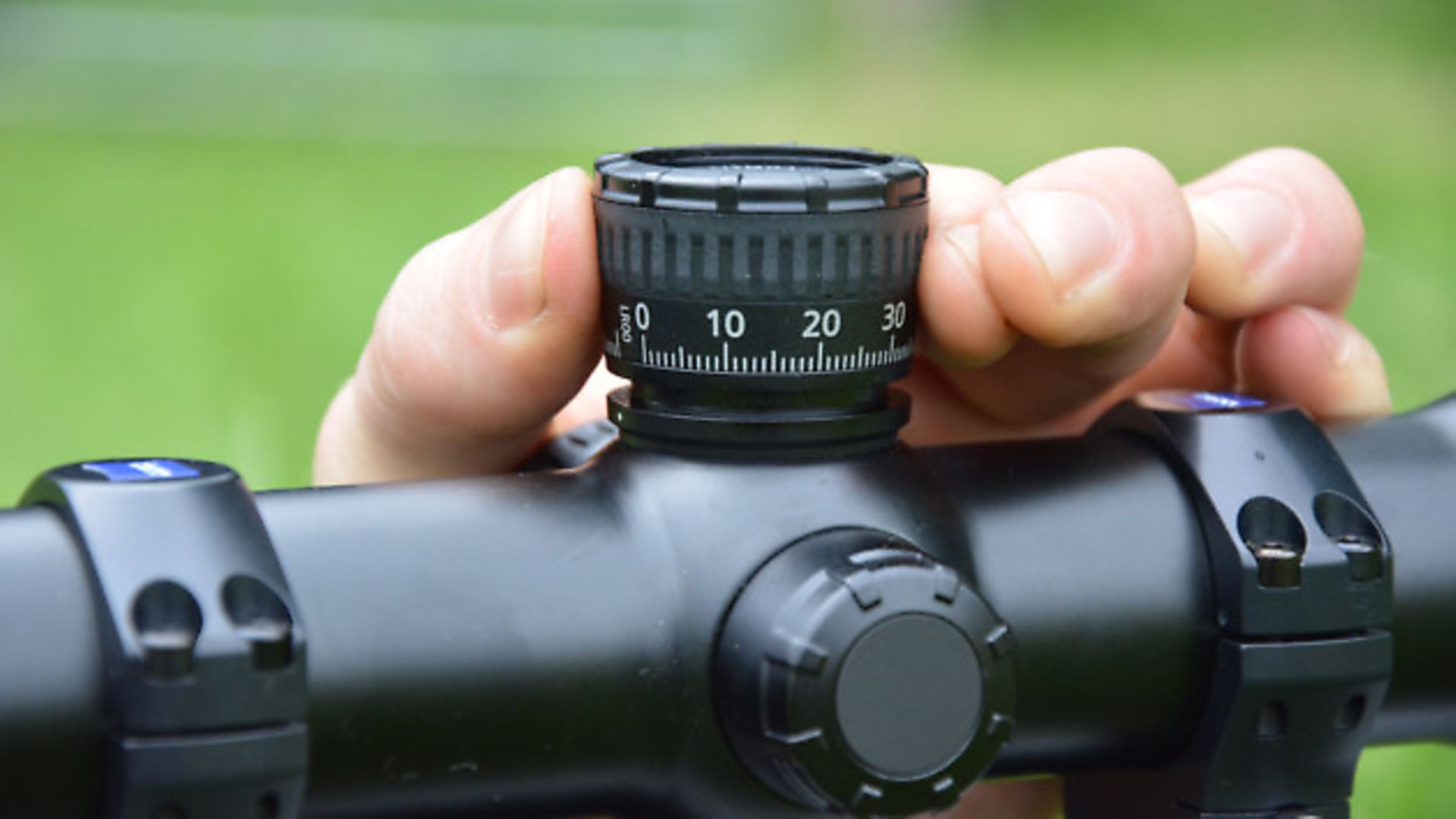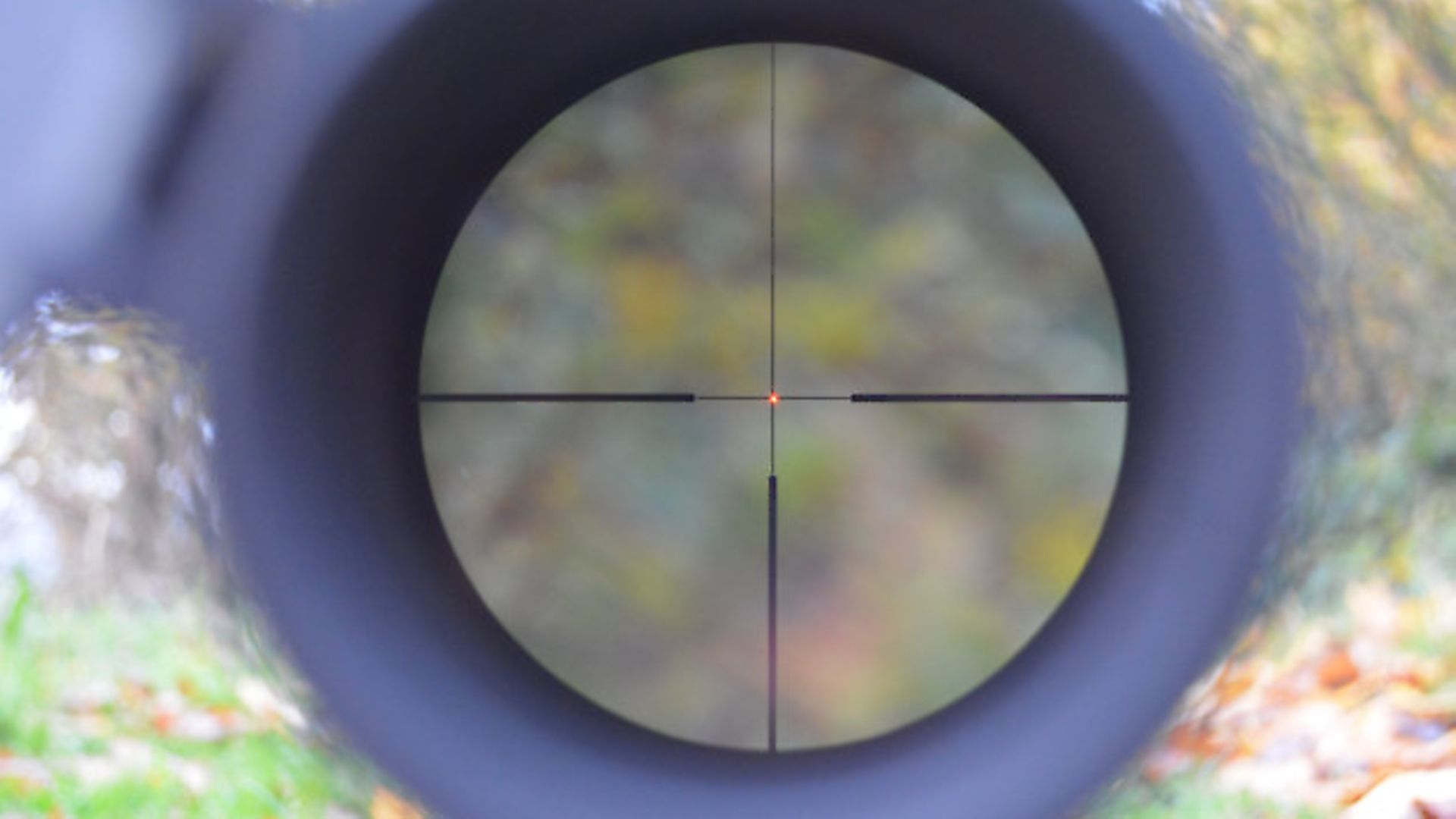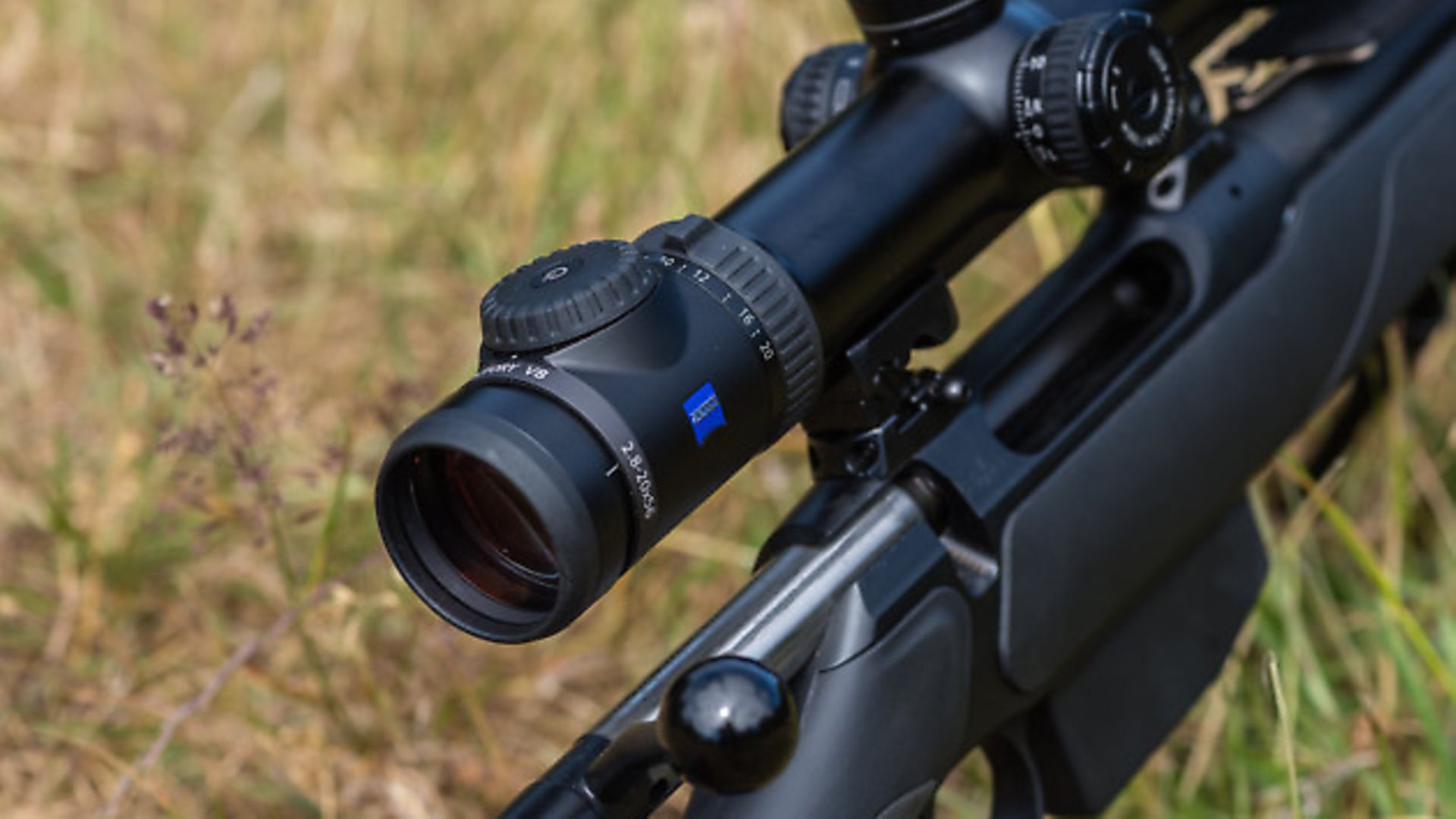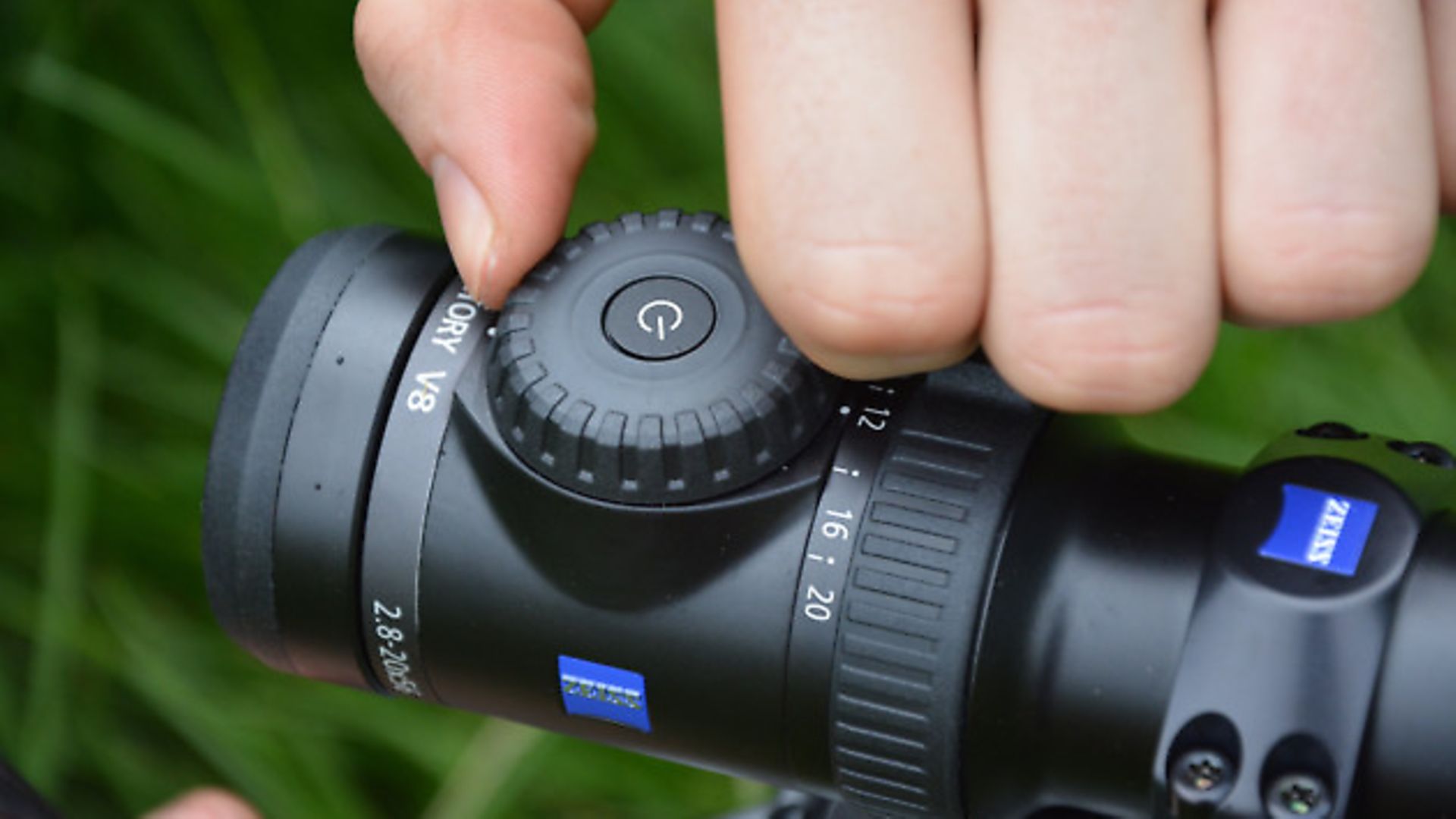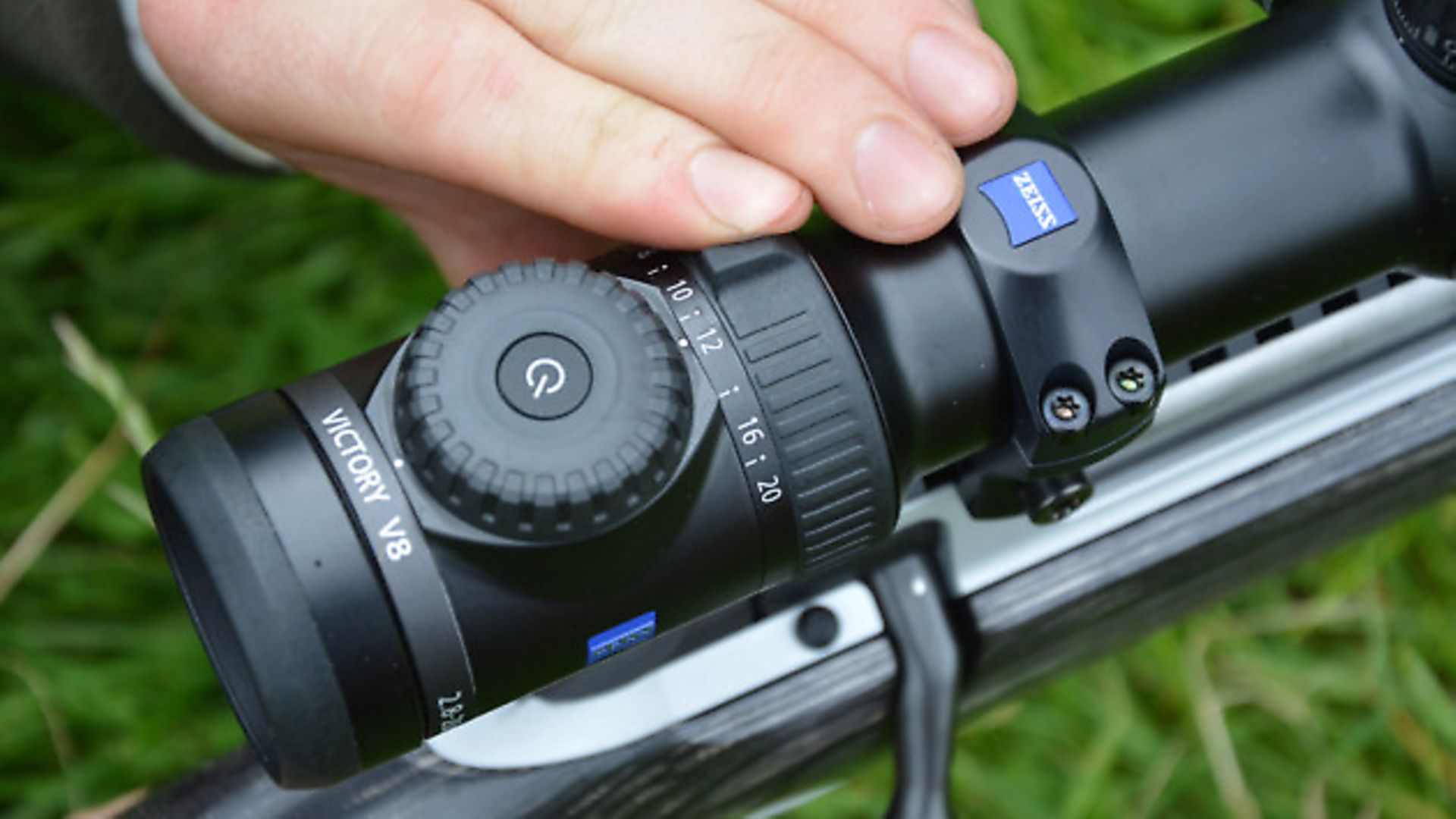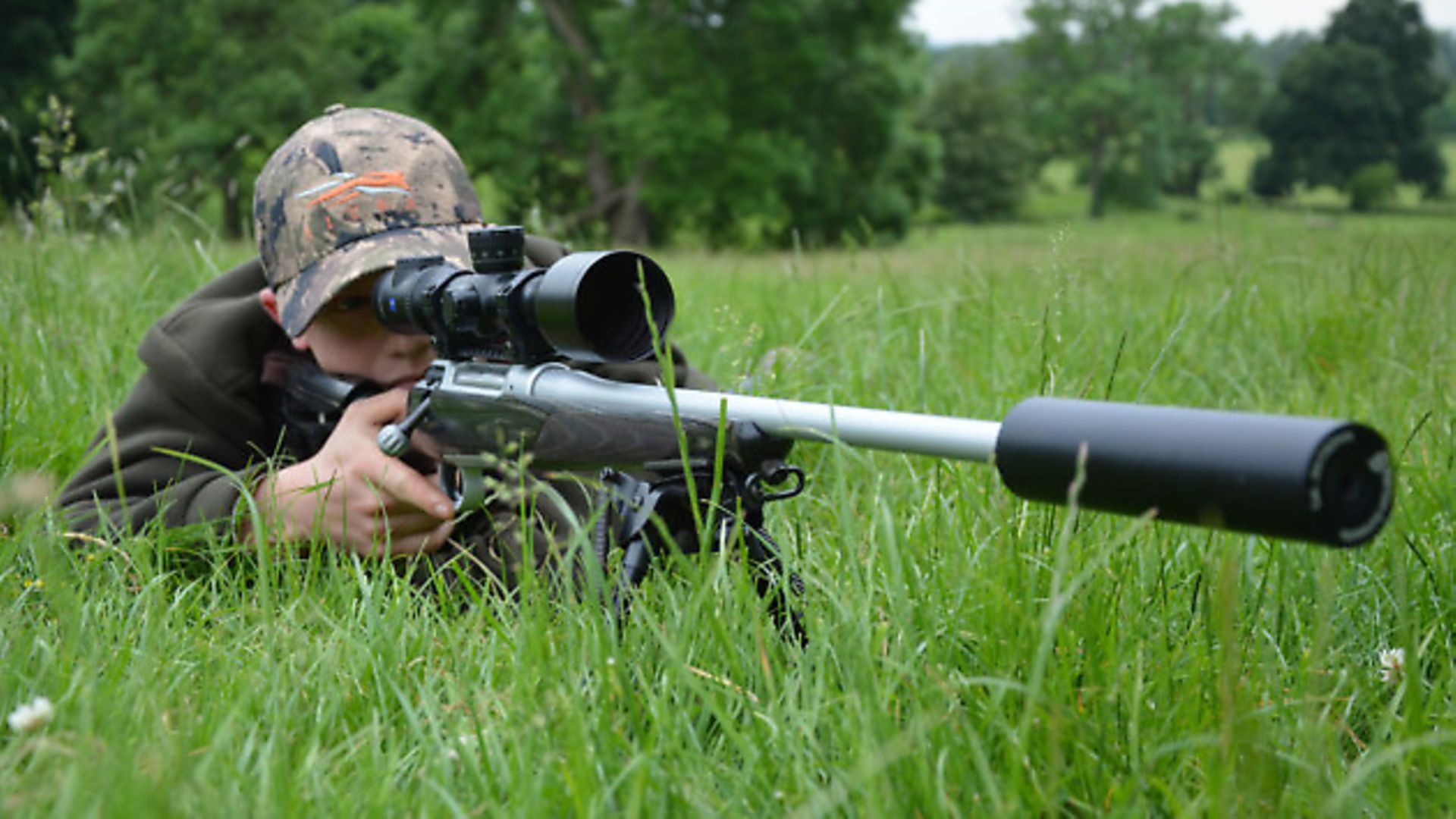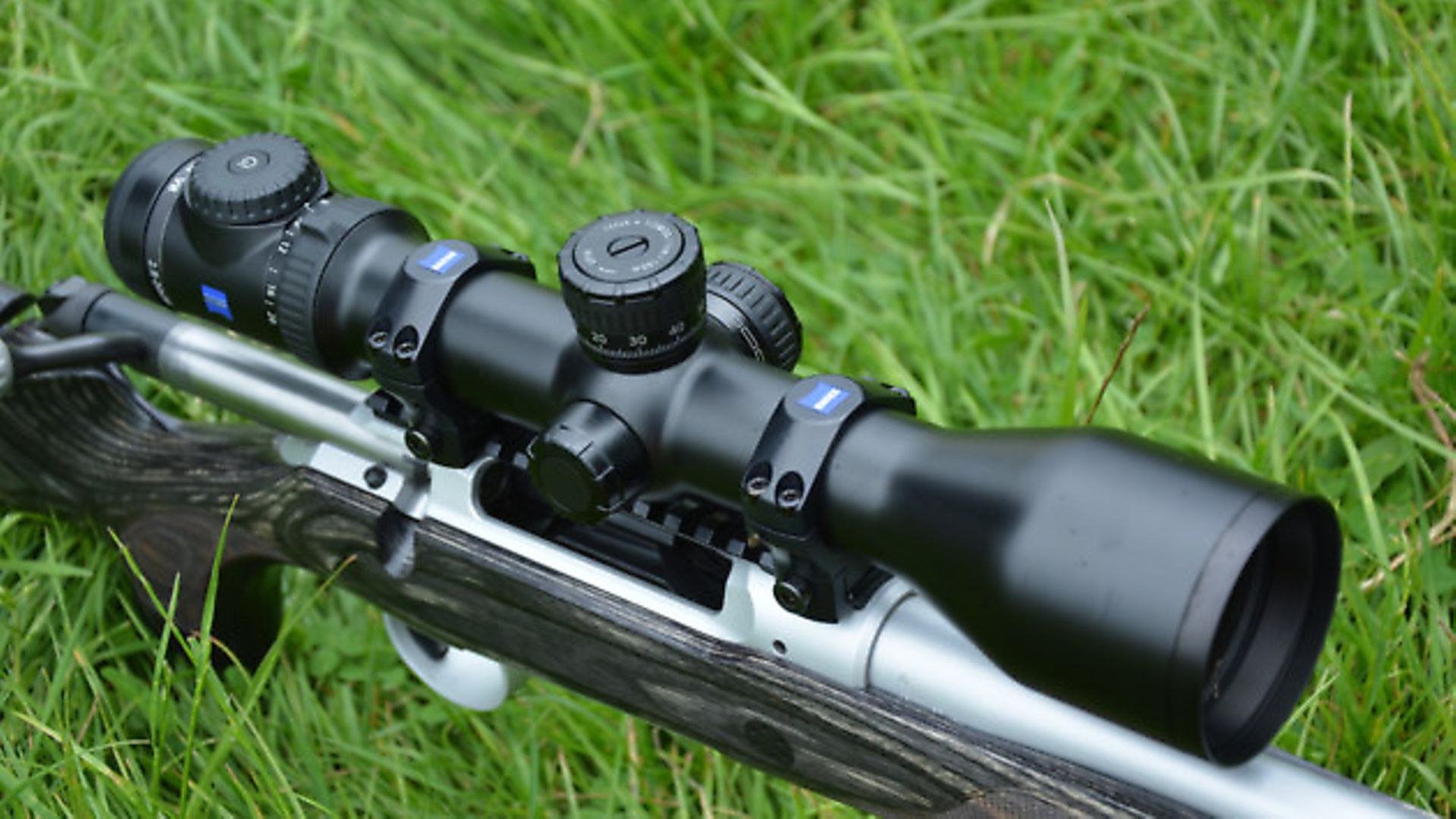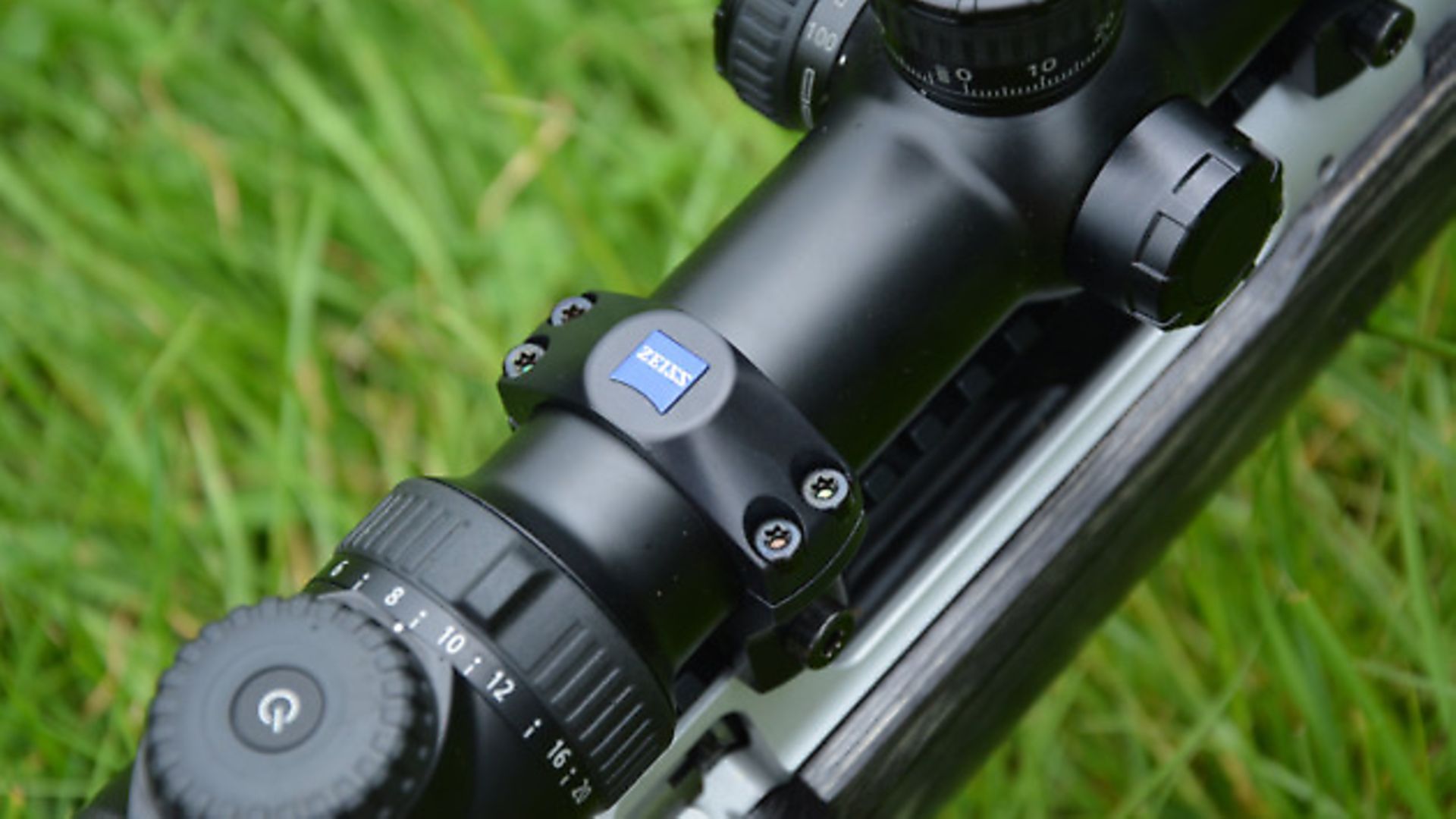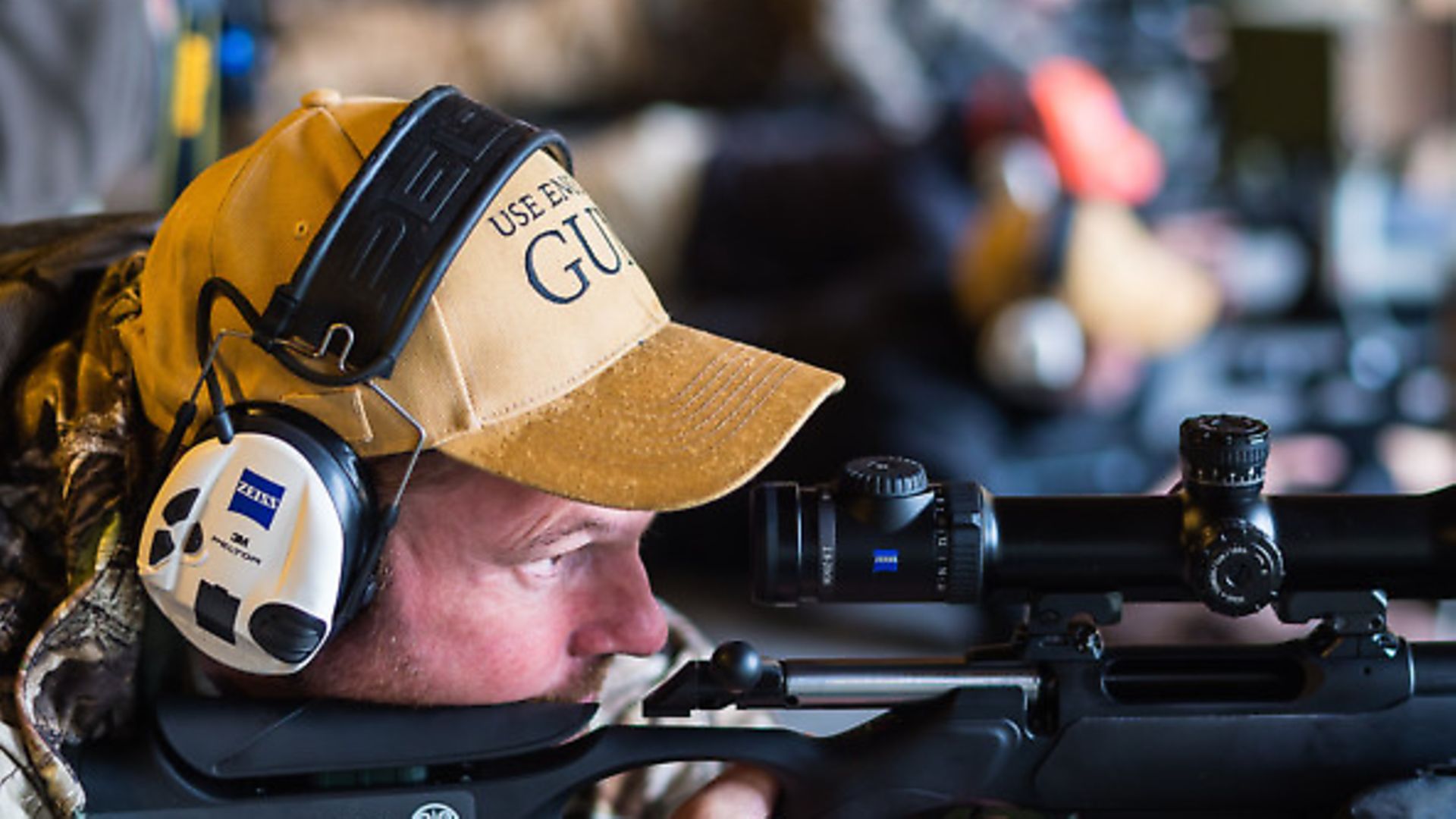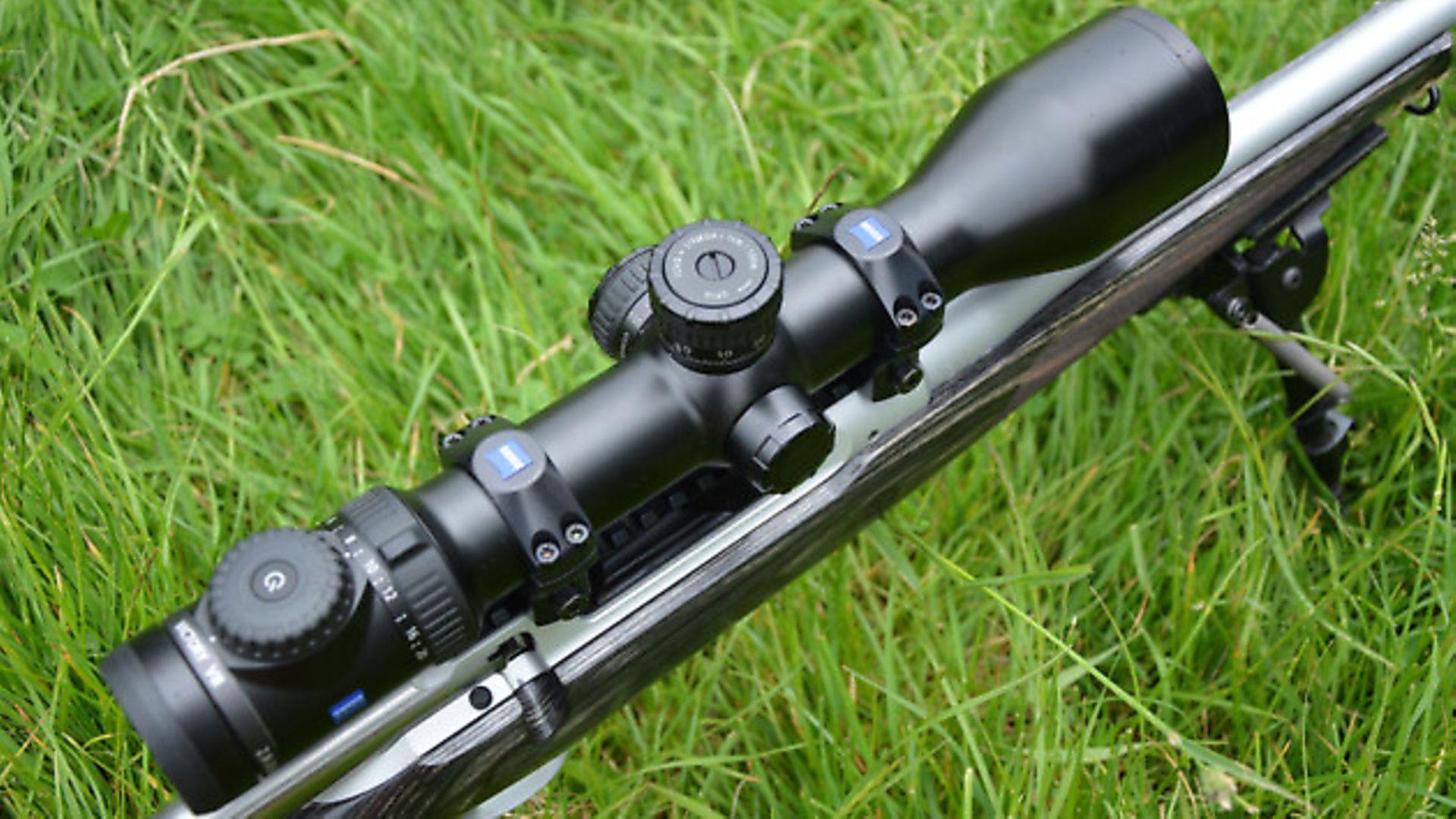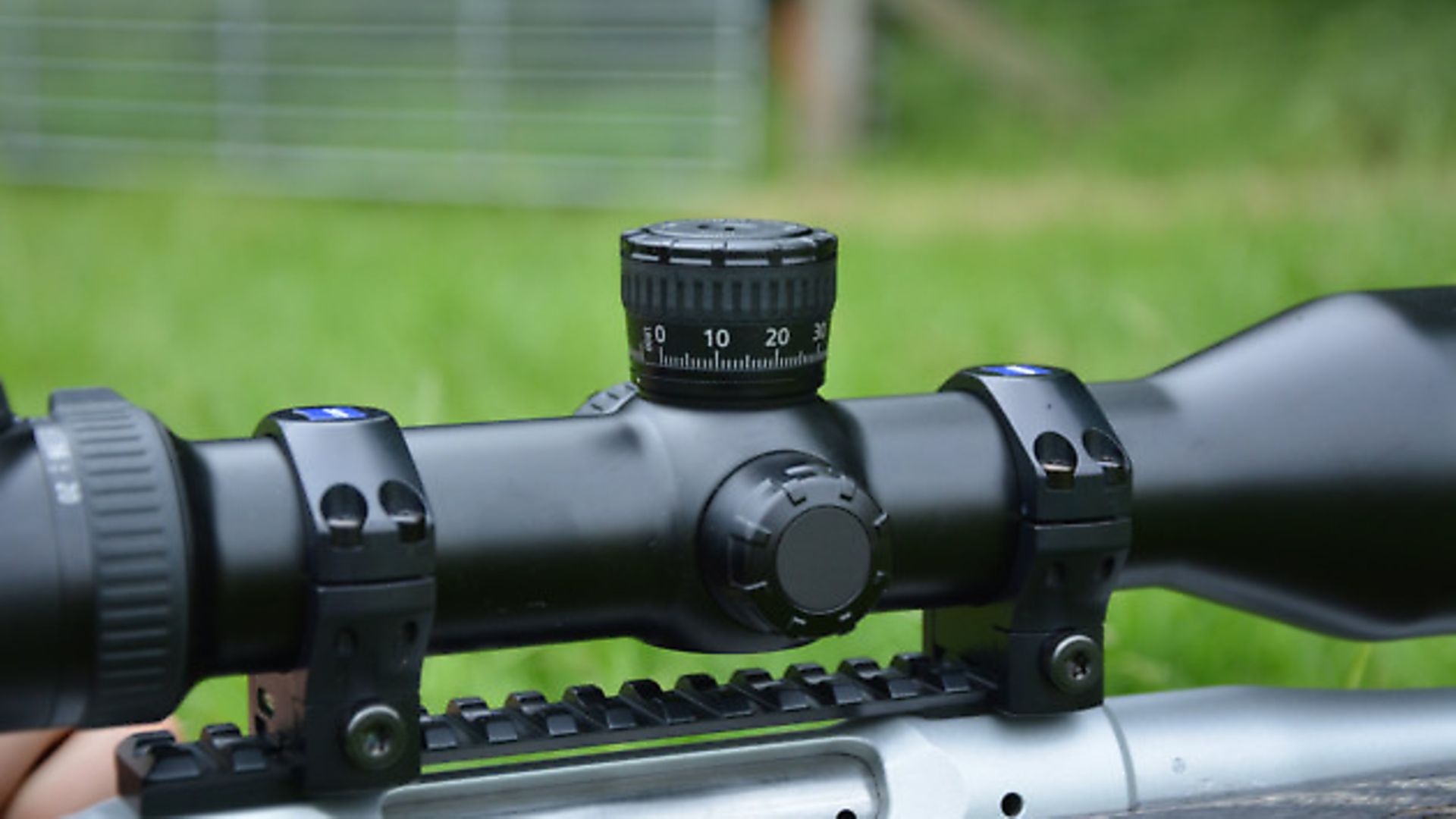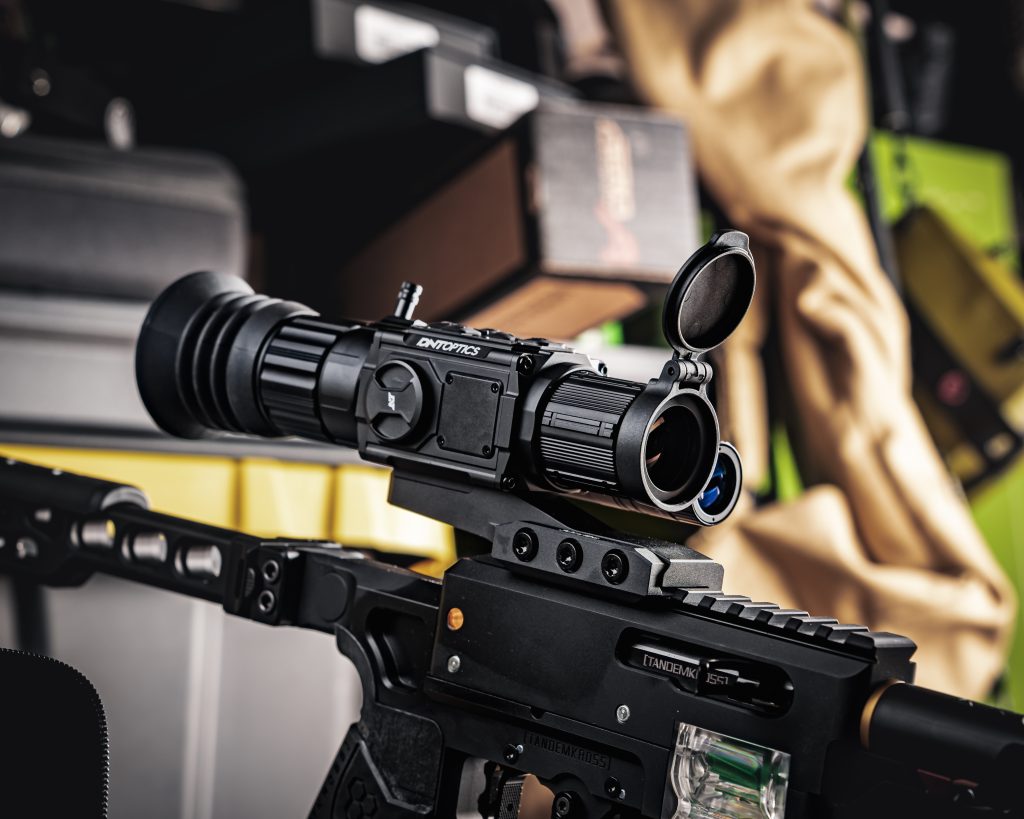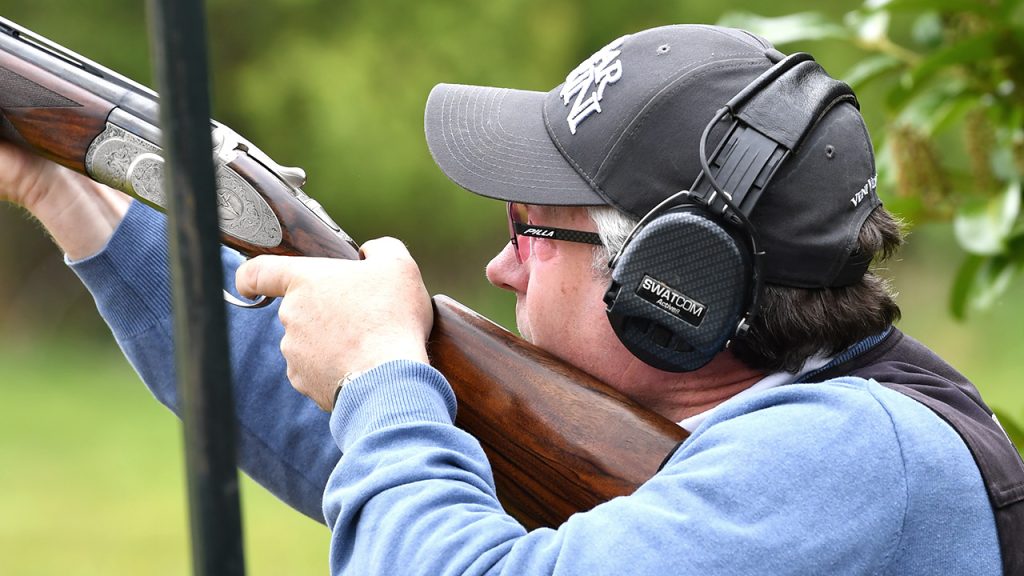Zeiss Victory V8 2.8-20×56 rifle scope – in depth review
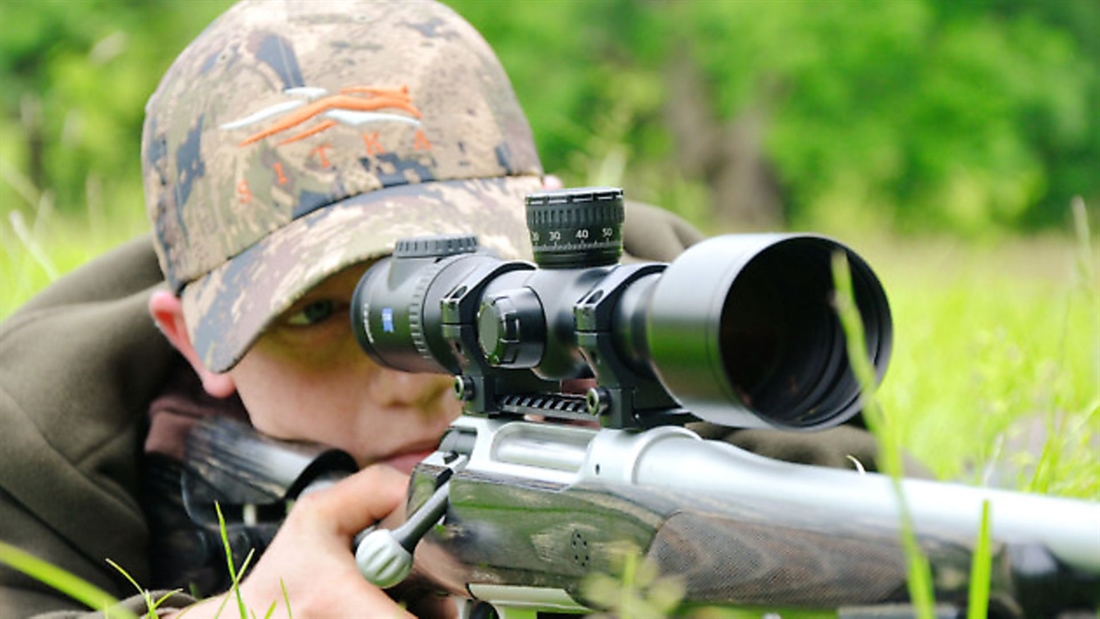
Jack Oats presents this detailed, in depth test and review of the Zeiss Victory V8 2.8-20×56 rifle scope
Technical Information
Model, Zeiss Victory V8 2.8-20×56
Magnification – 2.8-20x
Objective lens – 56mm
Main Tube Size – 36mm (Rail mount also available)
Reticle – Zeiss No.60
Illumination – On/off, with auto off when vertical or laid on side, rotary intensity control
Exit Pupil Diameter – 9.9-2.8 mm
Eye relief – 95 mm
Field of view – 15.5-2.1 m/100m
Light Transmission – 92%
Dioptric compensation – -3.5/+2 Dioptre
Impact Movement per Click – 10 mm@100m
Windage and Elevation Adjustment Range – 210 vertical/135 horizontal cm
Parallax Correction – Yes
Elevation Adjustment – ASV LongRange turret
Windage Adjustment – Cap dial as standard, ASV Long Range optional
Weight – 830 g
Length – 350 mm
Water resistance – 400mbar
Warranty – 10 Years mechanical/optical (2 years’ illumination)
For
Excellent reticle design and proportions
Fast accurate turret adjustments were guaranteed
Eye relief was well specified with a good field of movement within it
Against
This level of functionality for long range comes at the cost of weight
Some guns might be tricky to find 36mm mounts for
Verdict
Two years after it first appeared the V8 still carries a well-deserved reputation, but the Swarovski Z8 may offer serious competition in this price and specification bracket.
Price
£2245 (£100 extra for ASV windage turret factory fitted)
36mm Weaver/Picatinny mounts P.O.A
www.zeiss.com/sports-optics
Also used
Sauer 101 Alaskan rifle in 308 Winchester
Blaser Sporting Ltd
020 76222116
Barton Gunworks Sound Moderator
07795 645994
Recknagel Picatinny Rail
Alan Rhone
01978 660001
Can one scope do everything? I have often asked this question and, after several years of shooting and research, I have come to the conclusion that the answer is definitely ‘no’… but that doesn’t stop manufacturers trying.
The first Zeiss V8’s I saw were grey imports, but as soon as they officially came on sale in this country, it was no surprise they were seen as the ultimate optic – but are they really? They offer a lot on paper, but reality in use can defy promises. The specification of 2.8-20×56 with first-class optics and fast adjustment for elevation seems to tick all the boxes, but when you scratch below the surface, all that glitters is not necessarily gold. Firstly, the ‘V8’ part of the name leads in the advertising, but it is just a name, not a specification; the magnification range on offer is actually 20/2.8, so 7.14x on paper. This is not an issue, but other manufacturers (specifically Swarovski) have caught up and superseded it with true 8x ability. This does lead to some awkward decimal specification numbers but, at the end of the day, either will satisfy most of your needs in this range.
The V8’s apparent bulk was also questioned with their 36mm main tube, but again this really doesn’t matter – the size of the tube between ocular and objective lens bodies is fairly free space within the whole rifle/optic package anyway. It does, of course, rely on access to a decent mounting solution, which are a little thinner on the ground for 36mm. Getting a 56mm objective fairly close to the barrel is advisable, but that suddenly gets tricky if you struggle to get 36mm rings, never mind low ones that have to fit between action/rail and tube itself. The weight is not insignificant at 830g, but you will not get physics for free and, when it comes to optical ability, get ready to see the advantages of that near-kilo total. I have owned other Zeiss scopes and seen the evolution of the ASV family of turrets, as they progressed in range and complication. Thankfully, Zeiss have chosen the simple 1cm at 100m click value, which works directly alongside the milliradian system, if you want to shoot at longer ranges and work in this unit, rather than counting clicks. The ASV LongRange turrets on the V8 simply lift to unlock, and you then turn to the position you require either during zero, or when dialling for shots at greater distance. They snap back down into place and are about as impossible as you could desire to accidentally nudge out of place, yet always fast when you need them. Extra collars are supplied with the scope to complement approximations of the general ballistics of many mainstream calibres, from either 100 or 200m zeros, but, as standard, the simple collar marked in centimetres is fitted. Slackening the top dial allows this collar to be turned to set zero above the pointer, but as a zero stop is accommodated within the turret mechanics it makes sense, in a calmer moment, to unscrew the dial with a screwdriver and lift the whole turret top, setting it against the rotation stop. When hunting this allows you to always rotate the turret anti-clockwise back to zero in any light conditions. All clicks are tactile for a good feel, and make small but not distracting noises which are unlikely to spook quarry. They are comfortable to operate when wearing gloves; grip is confident due to rubberisation of the dial. The elevation turret is supplied like this as standard, but windage is a conventional finger dial underneath a cap. A similar windage ASV LongRange turret can be specified at extra cost (£100) but I feel it is wrong to start dialling for excessive wind in hunting conditions. I treat range alone with due respect and that is the easy part. I always err within the acceptable kill zone on an animal for windage, and if I need to go further abroad than there, is the shot acceptable? Regardless of this, the dial uses similar 1cm clicks and can be reset with a lift to silently turn the visual zero-point left and right.
Within the 36mm diameter tube’s mechanics, 210 clicks (2.1mRad) are available for elevation, with 135 (1.35mRad) for windage. This is acceptable, yet the term ‘long range’ is very user specific, and you may or may not need more depending on your definition. The ASV LongRange elevation turret allows 100 of these clicks to be accessed with one complete rotation, before ending at the far side of the zero stop, and this is the limit of your range in perfect conditions without any partial turret disassembly, which I wouldn’t recommend anywhere other than the workshop. It would give something like a 150gr .308 round capability to approximately 875m or so, which is hopefully well beyond your hunting engagement ranges, but perhaps not far enough for a trip to Bisley on targets when training. If you really want to maximise the potential here, you could (and I accept this could cause confusion), remove the zero-stop pin in the elevation turret with a set of needle nose pliers. This gives the full range of the scope in all circumstances, but losing track of your adjustments is more probable. I personally don’t see this as a target scope and, on a hunting set-up, 800m capability would far exceed my requirements. It is worth taking the chance to fit an inclined scope rail or mounts to make sure you can access the full range of the scope’s travel; you will have used up some of the available 210 clicks when initially zeroing it.
Other features and functions of the scope are of the usual style with equal smoothness and cleanliness of both manufacture and function. The reticle illumination controls are simple to operate with no excess unused functionality. Press/hold the button down to turn the centre dot in the No.60 Zeiss reticle on or off, and spin the dial to vary the intensity. Your setting is saved when you turn it off and it has auto power off, as well as what I call ‘lazy settings’, when you prop the gun up vertically or lay it on its side. It re-illuminates instantly and I never once found myself with a dead battery or a damaged switch, or found that the unit was turned on or off when it shouldn’t be. This is a minor point to make, but it’s nice to see it done well where others get ahead of themselves with excessive functions and physically delicate controls you don’t actually use.
As my eyes age, I use the extra range from the fast-focus eyepiece from -3.5/+2 dioptre to offer me an ultra-crisp reticle focus. The No.60 is a little heavier than others and doesn’t get mixed up into the background where grasses, crops, branches and trees interfere with your line of sight, and that is without the reticle illuminated. It sits in the rear focal plane so remains constant in size, regardless of applied magnification setting, so with little other than simple three, six, and nine o’clock stadia, that central floating dot remains distinct. There are no suggestions of aim-off marks, so I like the cleanliness and boldness of the picture offered with no distraction. Although the Zeiss Rapid Z is a good reticle, I prefer – and find it faster – to lift and turn a turret with large visible numbers, than to try to read the minute etchings next to a ladder reticle on a scope that’s magnification could easily be left on the incorrect setting anyway.
The fine centre dot’s red glow is precise, covering only 3.3mm of the target at 100m, and correspondingly more as range increases. As would be expected from Zeiss, it remains sharp and never dazzles, flickers or shines, even at its highest intensity in daylight. Set a little dimmer, it is easy and relaxing to acquire in darker conditions, and is without doubt the best reticle for my needs and eyesight. At 36mm, the main tube allows larger internal diameter for lenses and mechanical movement. The Fluoride lenses feature all of Zeiss’s proprietary coatings for light transmission and abrasion resistance, as well as water shedding. Schott glass is an unsurprising foundation component, and the image quality does not disappoint.
Parallax control is available on the turret to the left of the saddle, which can be left set at 150-200m and virtually ignored for most normal hunting situations, regardless of magnification. The depth of field is very versatile and you only really notice and require independent control when using full magnification at shorter ranges.
Eye relief is listed at 95mm, but along with the field of view, it’s very easy to remain within the centre of the exit pupil regardless of your shooting and head position. This versatility is an outstanding feature of such a widely capable optic, and even though 20x seems a lot for hunting and minimal for target, you don’t get cramped into a fixed position and a tunnel when set up for these long shots. Your field of view and spatial awareness are fantastic. If prone, it seems to minimise the strain on your neck when remaining on the gun for extended periods. If the quarry moves and you have to pan and track it, you are reminded of this field of view, as well as the flat field of view right across the lenses with no hint of chromatic aberration, even with the sun heading in towards you and viewing into comparative darkness. The colours seem to remain a little sombre but always with good contrast, even in lower light conditions. Target image resolution is beautifully clear with fine details instantly perceivable.
Given that 2.8x magnification is available, it is not unexpected to use a scope like this for occasional moving targets, and the fast accessibility of the exit pupil is appreciated here. Conversely, the 36mm tube can make finding mounts difficult for some rifles, (Zeiss supplied me with a set of Weaver/Picatinny compatible mounts), but not for all. When it comes to serious driven guns, a 30mm tube can be advantageous as it allows the scope to be closer to the action on a rifle that, if fitted to you, gives more intuitive pointability even when you are using a smaller objective like a 30mm, especially if you also require swing-off mounts. These points don’t particularly apply to this model, but a 1.1-8×30 V8 with similar 36mm tube is available, so think ahead if that is what you are intending.
For low-light specialists, Zeiss’s Schott HT glass is tested and approved to 92% light transmission, and the brightness of all images is without question. The supposedly lesser Zeiss Victory HT range actually boasts 95% transmission on paper, but I have yet to see a great difference in the real world. I didn’t use any of the ballistic rings supplied as I prefer to try out my settings on paper, and although they are close to most calibre bands, it’s so easy to wrap your turret in white electrical tape and mark off your desired adjustments.
The calibre-specific rings are graduated with 25/50/100m increments, which were always about right, but why chance approximating what is easy to get right when you still have the windage to consider which is far harder to compensate for? Zeiss can custom make these collars specific to your calibre’s ballistics, but if you were to consider that the most probable long-range shots you might take are likely to be done in mountainous areas with humidity, elevation and temperatures significantly different to your practice locations, is it worth relying on one? It’s perhaps better to learn to set these up on location yourself.
The V8 is a fine scope, and for long-range mountain hunting I don’t think it has an equal, yet its weight is at odds with a mountain rifle. The optics, reticle and mechanics have proven themselves to me time and time again, but for lowland stalking the plain HT is lighter and more compact. For target shooters it is great for practising realistic hunting scenarios, but not for tiny specs of orange at 1,000m. I could go on, but there isn’t a perfect scope for every single use and there probably never will be; still, the V8 name keeps cropping up very high in the mix.
Related Articles
Get the latest news delivered direct to your door
Subscribe to Rifle Shooter
Elevate your shooting experience with a subscription to Rifle Shooter magazine, the UK’s premier publication for dedicated rifle enthusiasts.
Whether you’re a seasoned shot or new to the sport, Rifle Shooter delivers expert insights, in-depth gear reviews and invaluable techniques to enhance your skills. Each bi-monthly issue brings you the latest in deer stalking, foxing, long-range shooting, and international hunting adventures, all crafted by leading experts from Britain and around the world.
By subscribing, you’ll not only save on the retail price but also gain exclusive access to £2 million Public Liability Insurance, covering recreational and professional use of shotguns, rifles, and airguns.
Don’t miss out on the opportunity to join a community of passionate shooters and stay at the forefront of rifle technology and technique.



